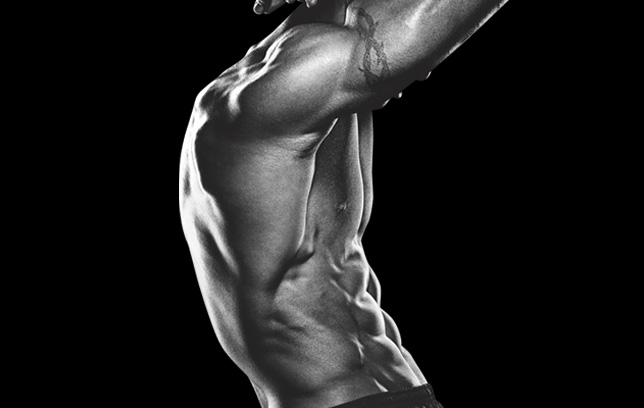At a fitness conference last Spring, I joined some friends for breakfast. It was a normal breakfast up until the moment Spencer Nadolsky, D.O., pulled a scale out of his gym bag to weigh a banana.
I knew Dr. Nadolsky was preparing for a bodybuilding contest. I knew drug-free bodybuilders get obsessive about their nutrition. They have no choice. When you’re already leaner than 99.9 percent of the population, it takes extraordinary discipline to get even leaner. But even within that demographic I’ve never heard of someone weighing each piece of fruit.
Physique competition is a deeply, weirdly fascinating pursuit. It’s hard to even call it a sport, considering that the goal is to show up with the most muscle, the least fat, the most aesthetically pleasing proportions, and the best posing routine. So while many bodybuilders were accomplished athletes (Nadolsky wrestled as a heavyweight at North Carolina, and won a lot more than he lost), and most are strong, those things don’t matter on stage.
It’s safe to assume that no one knows more about getting ripped than natural bodybuilders. And thanks to a 2014 review in the Journal of the International Society of Sports Nutrition, we have all the known research on their pre-contest eating strategies in one handy place. Its authors include Alan Aragon, the longtime nutrition advisor for Men’s Health.
Three key lessons from the study:
1. Slow-jam the weight loss
Everything we want these days, we want as fast as we can have it. You’d never have clicked on this article if the headline was, “Get shredded in 4-6 months by training your ass off and eating a lot less.” But that’s the most reliable way to reach single-digit body fat while retaining most of your muscle mass.
When you lose it faster, you lose more muscle, and you run a greater risk of slowing down your metabolic rate as your body compensates for the sudden reduction in calories.
A reasonable goal, the study suggests, is to lose 0.5 to 1 percent of your body weight each week. For example, let’s say you currently weigh 200 pounds, with 15 percent body fat. Simple math tells us you have 30 pounds of fat, with 170 pounds of lean tissue.
If you lost half your body fat—15 pounds—without losing any muscle, you’d weigh 185 pounds, with 8 percent body fat. Which would be awesome, but unrealistic. A more reasonable goal: 180 pounds with 9 percent body fat. To get there you’d need to lose 14 pounds of fat, with the regrettable loss of 6 pounds of muscle.
Twenty pounds is 10 percent of your starting weight. If you lost 1 percent a week, the highest recommended rate, it would take 10 weeks. But not really, because 1 percent of your current weight will be a smaller number each week. And the leaner you get, the harder it will become to get even leaner. A more realistic target: 16 weeks. Want a cutting-edge plan you can start now? Check out The Lose Your Spare Tire Program. It’s the easiest and most effective way to drop 20, 30, or even 50 pounds—and flatten your belly forever! (Editor’s note: The first 1,000 people who enter the coupon code MHREADER1 at checkout will save 50% off the program.)
How to lose the weight? You can start by cutting 500 daily calories from your current diet, which works out to a loss of 1 pound of fat a week … for a while. Then the math gets screwy as your metabolism shifts to compensate.
But there is a way to reduce that risk.
2. Pump up the protein
You know all about the benefits of protein. You know it speeds up your metabolism, and helps you preserve muscle tissue when you’re eating below maintenance. But you probably don’t know just how much of it bodybuilders eat when they’re preparing for a contest.
The recommended range is 2.3 to 3.1 grams per kilogram of lean body mass. In our example, you start with 170 pounds of lean tissue, and hope to have 164 pounds by the time you reach single-digit body fat, which is about 75 kilograms. So your minimum protein target is 170-ish grams a day. At the high end you would eat 230 grams.
No matter how much you like eggs, poultry, or fish, that’s an absolutely massive amount of protein. Even if you figure 40 grams a day will come from a protein shake, you still need to choke down the equivalent of 4 to 6 chicken breasts.
3. Keep the carbs, cut the fat
The conventional wisdom of the ‘80s and ‘90s was that fat made you fat. The less fat you ate, the better. Today, it’s a given that the fewer carbs you consume, the leaner you’ll get. So it may come as a shock to see that bodybuilders typically use a low-fat diet: 15 to 30 percent of their total calories.
That doesn’t mean their diet is high in carbohydrates. Not exactly. It just means that a bodybuilder who’s cutting calories while also training longer and harder needs the carbs for energy to fuel his workouts. Some fat is necessary for health, and to keep testosterone levels up. But out of the three macronutrients, fat runs a distant third in importance when your goal is to get as lean as humanly possible.
Ready for some math?
We’ll say you’re currently eating about 3,000 total calories on an average day. Since you want to subtract 500, your new target is 2,500 a day. (This is based on nothing, other than my need for nice, even numbers. The actual amount you would need for super-low body fat might be more or less.)
For protein, we’ll split the difference in the previous example, and say your goal is to eat 200 grams a day. That’s 800 calories, or about a third of your total.
We’ll also split the difference for fat, and say it’ll provide 22 percent of your total calories. That’s 550 calories, or just over 60 grams a day. It’s the equivalent of 4 tablespoons of olive oil, plus one egg yolk.
That leaves us with 1,150 calories for carbohydrates, or about 287 grams a day. It works out to about 45 percent of your diet. On paper it looks like a lot, but in the context of an aggressive fat-loss program, when you’re training an hour a day and eating less than you’re used to, it probably won’t seem like much at all.
The closer you get to your deadline, the more crucial it is to hit your calorie target on the nose. Maybe you can overshoot your protein goal without putting entire project in jeopardy. (Protein, as you may know, helps to limit your appetite.) But if you regularly exceed your allotments for fat or carbs, you can probably forget about reaching single digits.
Which brings us back to Dr. Nadolsky and his scale. When I asked him about it for this article, he agreed that “weighing bananas sounds ridiculous.” But while a medium banana has just over 100 calories, including 25 or 26 grams of carbs, the actual banana you have with breakfast might be bigger or smaller. “I’ve had bananas that differ by 100 percent,” he said.
The lesson here is an important one: If you’re careless about one thing in your diet, chances are you’ll be careless about others. By the end of the day you might be off by a couple hundred calories. No big deal for most of us, most of the time. But when you’re shooting for a level of leanness you’ve never achieved, one the average guy can never hope to reach, you can’t afford to be careless.
-(MensHealth)














